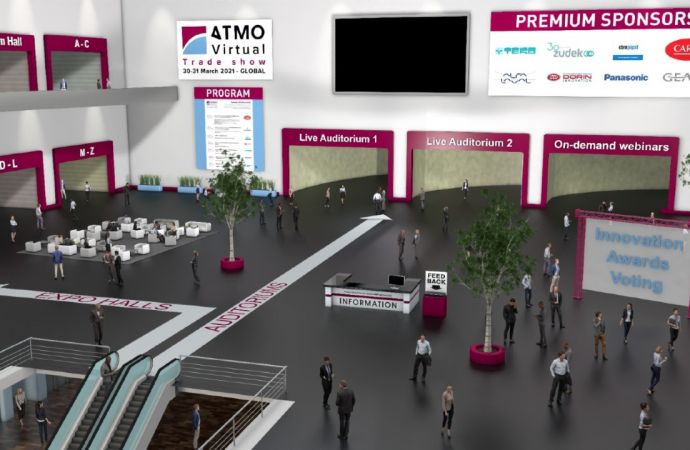ammonia21.com is among the 1000+ participants that have gathered this week in California for the IIAR 2010 Industrial Refrigeration Conference. This first article provides an overview of a selection of technical papers as well as the keynote speech presented at the event. + PHOTO GALLERY

‘Energy Conservation’ is the central theme of this year’s edition of the IIAR Industrial Refrigeration Conference organised by the International Institute of Ammonia Refrigeration (IIAR) between 14-17 March 2010 in San Diego, California. Accordingly, technical papers, workshops and panels are being dedicated in informing participants of the latest operating procedures and design strategies that reduce operating costs and boost the energy efficiency of systems, improving the bottom line.
ammonia21.com provides you with an overview of some of the presentations given at the event:
Keynote speech by Gerard N. von Dohlen, President, Newark Refrigerated Warehouse
‘I don’t want to be smart, I want the system to be smart’, alleged Gerard N. von Dohlen, President of Newark Refrigerated Warehouse at his keynote speech opening the IIAR 2010 Industrial Refrigeration Conference & Exhibition on 15 March. The C.E.O. of a company operating two public refrigerated warehouses in the New York area reminded the audience that the core technologies of refrigerated warehouses are IT and Material handling rather than refrigeration. However, with refrigeration having an increasingly important role on the bottom line of refrigerated warehouses due to energy consumption, warehouses are increasingly looking into measures that can reduce this energy consumption. Accordingly, the latest trends in refrigerated warehouses are moving towards energy consumption reductions of about 60%. Taking the perspective of a customer, von Dohlen maintained that what he needs from a refrigeration system is the following:
'Optimization of Refrigeration Plant Operation Engineering Approach', Sergei Khoudiachov, S K Energy Consulting Ltd
This paper discusses the nuances of major energy saving measures to maximise the operation efficiency of refrigeration plants, including: operating refrigeration plants at condensing pressures as close as possible to the optimum pressures; optimisation of suction pressure; optimisation of defrost settings; use of VFDs; optimization of compressor sequencing; and remote tuning. The author of the paper further discusses the misconceptions, hesitance to implement, and solutions to common missteps in the process.
'Ammonia Refrigeration Design for LEED Certification', Tom Dosch, C & L Refrigeration
This paper describes how a refrigerated warehouse with an efficient refrigeration design using ammonia can achieve LEED certification. It draws on the case of a facility being built in San Diego that employed early and extensive analysis to determine the cost effectiveness for design alternatives and efficiency investments including: R-22 versus ammonia, high-rise building and material handling, LED lights, rainwater recovery, water-saving measures and solar (PV) generation. Controls and mechanical equipment were designed to make the entire system “variable capacity.” These design features helped the facility owner achieve LEED Gold certification while holding four times as much product as their existing facility and using half the energy.
'How the PSM Mass and Energy Balance Relates to Your Plant’s Energy Usage', Marcos Braz, MRBraz & Associates
OSHA and US EPA regulations require that a mass and energy balance be performed and documented on systems that exceed a charge of at least 10,000 lbs. of ammonia. These documents are useful for the safety reasons that are intended by the agencies, but they also help personnel and consultants analyse and easily understand complex systems. This paper explains the development of the Mass and Energy Balance (MEB) documents and how they can be used to help save energy and capital improvement costs and improve operations. Use of MEB can help to determine if there are shortcomings in facility operations or in the refrigeration system itself. The MEB can also be used to help determine the extent of work required for an addition or retrofit of an existing refrigeration system.
ammonia21.com will be publishing an interview with Marcos Braz next week.
'Consider Two-Stage Systems to Save Power', Richard A. Corbett, R.A. Corbett Engineering
This paper compares low-temperature ammonia refrigeration systems using single-stage screw compressors to traditional two-stage systems. It compares performance data for both types of systems and estimated operating costs based on total brake horsepower (BHP) requirements for each type of system. The performance data shows that two-stage systems provide significant power savings without significantly increasing system complexity. The data also provides guidance for when to specify two-stage systems over single-stage systems.
ammonia21.com provides you with an overview of some of the presentations given at the event:
Keynote speech by Gerard N. von Dohlen, President, Newark Refrigerated Warehouse
‘I don’t want to be smart, I want the system to be smart’, alleged Gerard N. von Dohlen, President of Newark Refrigerated Warehouse at his keynote speech opening the IIAR 2010 Industrial Refrigeration Conference & Exhibition on 15 March. The C.E.O. of a company operating two public refrigerated warehouses in the New York area reminded the audience that the core technologies of refrigerated warehouses are IT and Material handling rather than refrigeration. However, with refrigeration having an increasingly important role on the bottom line of refrigerated warehouses due to energy consumption, warehouses are increasingly looking into measures that can reduce this energy consumption. Accordingly, the latest trends in refrigerated warehouses are moving towards energy consumption reductions of about 60%. Taking the perspective of a customer, von Dohlen maintained that what he needs from a refrigeration system is the following:
- to ‘minimise charge’
- be as standard a solution as possible
- low maintenance cost
- have lowest compliance costs and risks (training, servicing)
- be simple to operate (to minimise human errors)
- be ‘reasonably’ efficient
'Optimization of Refrigeration Plant Operation Engineering Approach', Sergei Khoudiachov, S K Energy Consulting Ltd
This paper discusses the nuances of major energy saving measures to maximise the operation efficiency of refrigeration plants, including: operating refrigeration plants at condensing pressures as close as possible to the optimum pressures; optimisation of suction pressure; optimisation of defrost settings; use of VFDs; optimization of compressor sequencing; and remote tuning. The author of the paper further discusses the misconceptions, hesitance to implement, and solutions to common missteps in the process.
'Ammonia Refrigeration Design for LEED Certification', Tom Dosch, C & L Refrigeration
This paper describes how a refrigerated warehouse with an efficient refrigeration design using ammonia can achieve LEED certification. It draws on the case of a facility being built in San Diego that employed early and extensive analysis to determine the cost effectiveness for design alternatives and efficiency investments including: R-22 versus ammonia, high-rise building and material handling, LED lights, rainwater recovery, water-saving measures and solar (PV) generation. Controls and mechanical equipment were designed to make the entire system “variable capacity.” These design features helped the facility owner achieve LEED Gold certification while holding four times as much product as their existing facility and using half the energy.
'How the PSM Mass and Energy Balance Relates to Your Plant’s Energy Usage', Marcos Braz, MRBraz & Associates
OSHA and US EPA regulations require that a mass and energy balance be performed and documented on systems that exceed a charge of at least 10,000 lbs. of ammonia. These documents are useful for the safety reasons that are intended by the agencies, but they also help personnel and consultants analyse and easily understand complex systems. This paper explains the development of the Mass and Energy Balance (MEB) documents and how they can be used to help save energy and capital improvement costs and improve operations. Use of MEB can help to determine if there are shortcomings in facility operations or in the refrigeration system itself. The MEB can also be used to help determine the extent of work required for an addition or retrofit of an existing refrigeration system.
ammonia21.com will be publishing an interview with Marcos Braz next week.
'Consider Two-Stage Systems to Save Power', Richard A. Corbett, R.A. Corbett Engineering
This paper compares low-temperature ammonia refrigeration systems using single-stage screw compressors to traditional two-stage systems. It compares performance data for both types of systems and estimated operating costs based on total brake horsepower (BHP) requirements for each type of system. The performance data shows that two-stage systems provide significant power savings without significantly increasing system complexity. The data also provides guidance for when to specify two-stage systems over single-stage systems.
MORE INFORMATION
Related stories
















